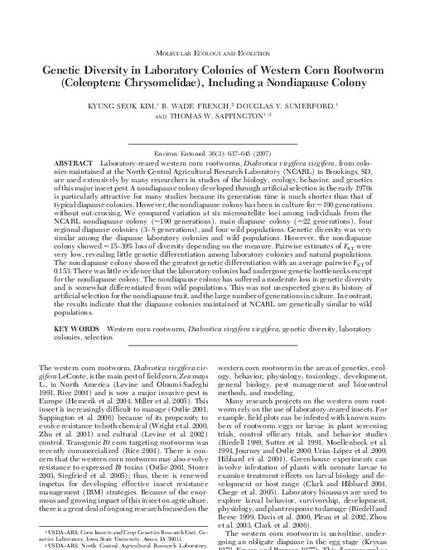
Laboratory-reared western corn rootworms, Diabrotica virgifera virgifera, from colonies maintained at the North Central Agricultural Research Laboratory (NCARL) in Brookings, SD, are used extensively by many researchers in studies of the biology, ecology, behavior, and genetics of this major insect pest. A nondiapause colony developed through artificial selection in the early 1970s is particularly attractive for many studies because its generation time is much shorter than that of typical diapause colonies. However, the nondiapause colony has been in culture for ≈190 generations without out-crossing. We compared variation at six microsatellite loci among individuals from the NCARL nondiapause colony (≈190 generations), main diapause colony (≈22 generations), four regional diapause colonies (3–8 generations), and four wild populations. Genetic diversity was very similar among the diapause laboratory colonies and wild populations. However, the nondiapause colony showed ≈15–39% loss of diversity depending on the measure. Pairwise estimates ofF ST were very low, revealing little genetic differentiation among laboratory colonies and natural populations. The nondiapause colony showed the greatest genetic differentiation with an average pairwise F ST of 0.153. There was little evidence that the laboratory colonies had undergone genetic bottlenecks except for the nondiapause colony. The nondiapause colony has suffered a moderate loss in genetic diversity and is somewhat differentiated from wild populations. This was not unexpected given its history of artificial selection for the nondiapause trait, and the large number of generations in culture. In contrast, the results indicate that the diapause colonies maintained at NCARL are genetically similar to wild populations.
Available at: http://works.bepress.com/thomas_sappington/8/

This article is from Environmental Entomology 36 (2007): 637, doi:10.1603/0046-225X(2007)36[637:GDILCO]2.0.CO;2.